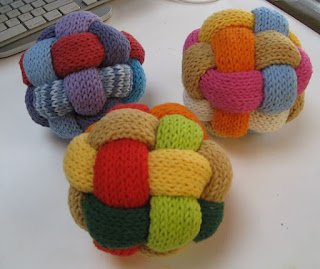 |
| 1) |
 |
| 2) |
 |
| 3) |
 |
| 4) |
 |
| 5) |
 |
| 6) |
 |
| 7) |
 |
| 8) |
 |
| 9) Form is similar to that of a Rhombicuboctahedron. Later, I worked out it is a skeletal octahedron. |
Hi
A few weeks ago, our friend Christine Durbridge came over after a summons from my wife Christine.
Our niece in England was having a baby (who has since been born, welcome to the world, Ed!) and Christine wanted to sew some decorations on some singlets, and was after technical advice. Now for all things sewing and knitting, Christine D. is the guru.
So Christine came around and the discussion somehow got onto a knitted braided ball design which Christine somehow produced pictures of using her ipad thingy (1, 2).
So the pattern for this ball (3) had been hanging around our house for a while, and one day I got out scissors, stapler and coloured paper, and made the paper equivalent (4,5). This is suggested in the knitted ball instructions as a guide to final assembly.
I wasn't quite satisfied with that! Questions such as "If this is a cube, what does the tetrahedron look like?" arose!
Anyway, as a sort-of answer, I have made a basket-cane topological equivalent of the paper cube (5 - 9). and it ends up looking like a chamfered octahedron or rhombicuboctahedron. ( Later, I realised it was a skeletal octahedron if the parallel rings are taken to represent sides) To make it, I used 6 of the 4 rod glue jigs I already had designed and made, 3mm basket cane, fold back clips, superglue, electrical heat shrink, and a hot air gun.
After making 2 rings using a heat gun, cane and heat shrink, the rings are joined by 2 jigs and fold back clips. Then an extra 2 canes are added. The new canes are closed as rings once they have been woven and clipped in place. A final set of 2 canes is then added, then closed to become rings. With the jigs still in place, all 24 cane crossings were glued with superglue. Finally, all fold back clips and jigs are removed. The last step should be done within a few minutes of glueing, as jigs can get permanently stuck to cane if you wait longer. Et voila! (9)
What other shapes can be made in the same pattern, I didn't know, and needed more think-time.
Regards Steve Nurse
Update after a bit of think time. I came up with the 2d patterns below which are flattened, chamfered tetrahedrons. By fiddling with the nodes, the pattern was "made" with 4 loops, 3 loops and 1 loop.
I will have a go at making a cane version of 10 and report back. (Later I recognised these patterns as similar to a stereographic projection of the structure, a type of 2d representation )
Regards Steve
 |
| 10) Base model 4 Loop tetrahedron. To be more accurate it is a tetrahedron with both edges and corners chamfered. |
 |
| 11) 3 loop tetrahedron with modified nodes |
 |
| 12) 1 loop tetrahedron with modified nodes. |
Update May 10, 2022
I drew a single path version of 12, with twists in the edges allowing the 6 edge tetrahedron to be made from a single strip of paper or a single piece of cane, and that is shown in 13. From then, with my wife Christine's help I made a paper 3d version of the tetrahedron plan shown in 10). The plan is shown in 14, the making of it in 15, and the results in 16, 17 and 18. It could be made from more colourful paper but otherwise I'm very happy. Will continue!
Regards Steve Nurse
 |
| 13) 1 loop tetrahedron with nodes preserved and switches in edges to achieve the single loop. In loose terms, it meets the criteria for |
 |
| 14) |
 |
| 15) |
 |
| 16) A 3d version of 10) |
 |
| 17) |
 |
| 18) |
Update, May 12, 2022
Today I made a new version of the paper ball shown in 18, and worked out I could make it from some thin A4 cardboard sheets I already had. It looks much better now. Might have one more go at this tetrahedron before trying the next (slightly more complicated) thing.








No comments:
Post a Comment